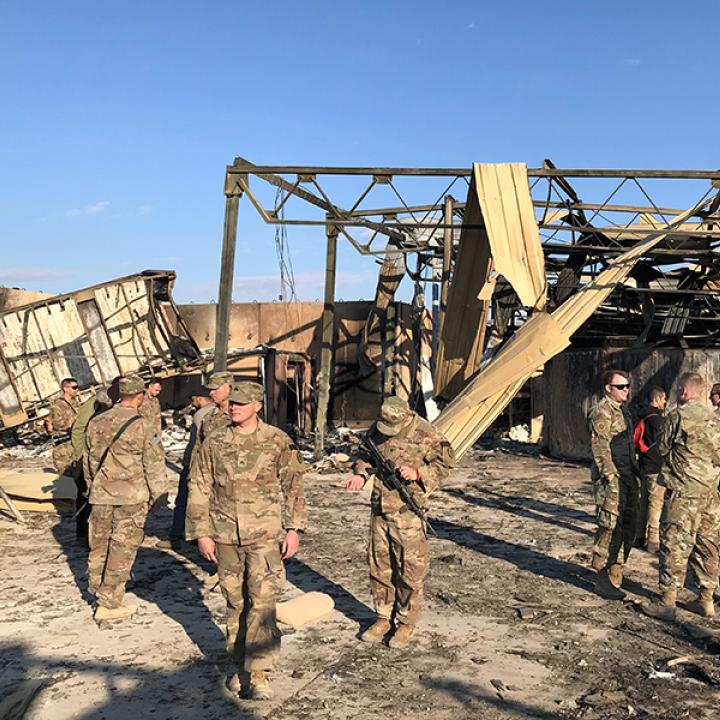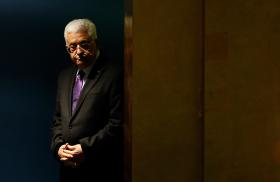
- Policy Analysis
- PolicyWatch 3265
U.S. Strategy Toward Iran: Restoring Deterrence, Enabling Diplomacy

Three experts discuss how Washington can manage escalation and catalyze diplomacy while still using its military instruments to apply pressure.
On February 7, Michael Eisenstadt, Kori Schake, and Lt Gen David Deptula (USAF, Ret.) addressed a Policy Forum at The Washington Institute. Eisenstadt is the Institute’s Kahn Fellow and director of its Military and Security Studies Program. Deptula is dean of the Mitchell Institute of Aerospace Studies. Schake is the director of foreign and defense policy studies at the American Enterprise Institute. The following is a rapporteur’s summary of their remarks.
MICHAEL EISENSTADT
In May 2019, Iran launched a counter-pressure campaign in response to the U.S. maximum pressure policy, aiming to induce Washington to ease or lift sanctions. This campaign has made extensive use of actions in the “gray zone” between war and peace. Gray zone actors probe and test to determine what they can get away with. They create ambiguity through covert or proxy activities and incremental action to make adversaries uncertain how to respond. They avoid decisive military engagement. They do all this in order to advance their anti-status quo agenda while managing risk, reducing the potential for escalation, and avoiding war. Iran’s gray zone strategy, and the proposed U.S. gray zone counterstrategy described below, are discussed in greater detail in the newly released Washington Institute report Operating in the Gray Zone: Countering Iran’s Asymmetric Way of War.
While there is potential for escalation and a broader conflict with Iran, an “all-out war” is unlikely—unless the United States opts for it—because the whole purpose of Iran’s gray zone modus operandi is to avoid such an outcome. For his part, President Trump has stated numerous times that he does not want a war with Iran.
The United States has always struggled to respond effectively to Iran’s gray zone strategy, and the current administration is no exception. Since last May, it has vacillated between excessive restraint and potentially escalatory responses such as the targeted killing of Qods Force commander Qasem Soleimani. His death added another layer of complexity to an already complicated multi-level game. First, there is a desire to avenge the killing of both Soleimani and Kataib Hezbollah militia leader Abu Mahdi al-Muhandis. Did Iran’s retaliatory ballistic missile strike on al-Asad Air Base in Iraq close the Soleimani file, or will Tehran also try to kill a senior U.S. military officer in response? As for Iran’s Iraqi proxies, it is safe to assume that Muhandis has not yet been avenged.
Another factor to consider is the impact of domestic politics. Iran’s hardliners have been working to marginalize their pragmatic conservative rivals. The country is also experiencing continued popular unrest, as are Iraq and Lebanon, all of which might influence future Iranian decisions. Indeed, domestic politics may have shaped Iran’s uncharacteristically prompt response to Soleimani’s killing, in a bid to demonstrate resolve lest the opposition perceive weakness and exploit it. Iran and the United States are also in an election year. Accordingly, Tehran may spring some kind of October surprise in an effort to cost President Trump his reelection.
Another question is whether killing Soleimani has restored U.S. deterrence. Deterrence has a short shelf life and must be constantly tended. Iran will seek to test U.S. resolve, and Washington must respond firmly to such tests—otherwise Tehran may be emboldened.
Iranian leaders face a number of dilemmas post-Soleimani. Their pushback campaign has not gained them sanctions relief and has cost them their most vaunted military leader. Further escalation with an unpredictable United States entails significant risk. They now have to ask themselves whether Soleimani’s assassination represents a new U.S. approach or a one-off event.
Moreover, pushing U.S. forces out of Iraq would have several adverse consequences for Iran: it would lose a powerful source of leverage over Washington; the threatened U.S. sanctions on Iraq would also hurt Iran; and Tehran would have to do the heavy lifting on its own in future campaigns against a resurgent Islamic State. Do the benefits of expelling Americans outweigh these potential drawbacks?
All of this Soleimani-related fallout underscores the need for a U.S. gray zone strategy toward Iran. Covert or unacknowledged gray zone activities would be less likely to disrupt U.S. efforts to negotiate a new deal with Tehran. They would also have a less disruptive impact on U.S. domestic politics, making the administration’s policy more sustainable at home. In addition, they would be more compatible with the operational environment—that is, they are less likely to evoke political backlash in places like Iraq, and more consistent with the demands of long-term strategic competition, which tends to be won on points rather than knockout blows. Lastly, they would be more compatible with a National Defense Strategy that seeks to shift U.S. focus and military forces to the Indo-Pacific region.
Key elements of such a gray zone strategy include the following: firmly responding to Iranian tests in order to bolster deterrence; using deterrence by punishment as well as denial; employing covert action whenever possible, and overt action when necessary; pursuing a balanced approach that avoids both excessive restraint and unnecessary escalation; acting unpredictably and asymmetrically in order to exploit Iran’s preoccupation with managing risk; altering Tehran’s incentive framework by not backing it into a corner; going long, not big, by seeking advantage through incremental gains instead of rapid, decisive actions; and expanding gray zone options so that vertical escalation is not the only choice available to U.S. officials.
KORI SCHAKE
The Trump administration’s theory was that Soleimani was uniquely able to strategize, build alliances, and execute asymmetric warfare. From their perspective, he had effectively built strategic depth for Iran. Yet while this assessment was largely correct, Soleimani’s strategy had seemingly passed the zenith of its success before his death. Preoccupied with seeking credit, he was running out of disaffected Shia populations to exploit, as demonstrated by the protests in Lebanon and Iraq. In that sense, it may have been possible to leave him in place and watch him fail while pursuing a strategy similar to the one used against al-Qaeda—namely, targeting number twos. Notably, however, Washington had not overtly responded to Iranian attacks on neutral shipping and Saudi oil facilities prior to targeting Soleimani, which had left American allies deeply anxious about their security.
The administration navigated the aftermath of his death very well, sending signals through the Swiss and taking steps to manage escalation. Iran’s panicked statements that the ballistic missile strike would be their only response helped stabilize the situation—an outcome facilitated by the administration’s outreach. In the end, however, Tehran is unlikely to stand pat on that retaliation alone, since doing so would validate the administration’s case that Soleimani was uniquely able to mobilize asymmetric responses. In fact, the regime already seems to be returning to the status quo ante, with proxies launching rockets at U.S. targets in Iraq.
To restore deterrence, U.S. officials need to work with their allies. Yet the Gulf states are realizing that Washington tends to be unreliable unless it holds deeply shared values with a given partner—and even then it cannot be depended on completely. Iraq’s situation is even more complicated, since Baghdad needs American assistance but also wants to restrict U.S. activities. In addressing these dilemmas, all parties need to keep in mind that the intelligence Washington receives from operating in and cooperating with other countries is incredibly valuable.
Regarding maritime cooperation in the Persian Gulf, allies have been hesitant to join the U.S.-led force. There are more countries in the French-led EU maritime force than in its American counterpart. The Trump administration’s reassurance strategy of deploying an additional 1,400 troops to the region and conducting targeted killings is insufficient. It is not a lack of military capability that makes U.S. partners nervous, it is lack of political reliability.
Washington’s best bet is to lead from behind. The Obama administration gave “leading from behind” a bad name, but when done correctly, it is a pretty good policy. Now is a good time to apply it in the Middle East, by quietly supporting friends while investing them with U.S. strength.
DAVID DEPTULA
The chances of all-out war with Iran are not high. Tehran’s main objective is regime survival, and the Trump administration has no appetite for another war in the Middle East. Uncontrolled escalation is possible but unlikely. President Trump set a redline of “no U.S. casualties” and warned Tehran not to cross it. When Iranian proxies killed a U.S. contractor in Iraq, he acted as promised to defend American personnel and interests.
Eliminating Soleimani aligns with Washington’s three-part strategy of (1) constraining Iran’s malign activities, (2) rolling back its influence in the region, and (3) deterring further aggression. The deterrent element is especially important; in order for it to work, Iranian leaders need to understand that the United States will use its power.
Killing Soleimani sent a particularly powerful message because he is not replaceable in the short term. He was Iran’s top terrorist, a leader of its revolutionary ideology, and an important strategic thinker. For now, at least, the Islamic Revolutionary Guard Corps will be less adaptive, and his former subordinates will struggle to fill his shoes.
Going forward, the fear of consequences should not preclude forceful U.S. action, which is sometimes necessary because inaction tends to increase the odds of further aggression. The most effective way to avoid war with Iran is to convince its leaders that continued aggression will come at an extremely high price. The United States can impose devastating costs on Iran, while Tehran lacks the means to respond in kind, which is why it relies on proxies and terrorism instead.
Washington also needs to move beyond its current anachronistic approach, which posits that large-scale ground maneuver is the dominant element of warfare. Effective jointness means using the right force at the right place at the right time, not using every force, every place, every time. If more robust U.S. action becomes necessary, then properly applied aerospace power supplemented by offensive cyber operations could collapse Iran’s economy, neutralize its military, destroy its nuclear program, and put an end to its regional influence. Iran’s critical oil refining capacity, oil distribution network, and power grid could all be rendered ineffective by these means, without any U.S. boots on the ground.
Accordingly, if Iran conducts further acts of aggression against U.S. personnel and interests, Washington should not follow the strategies applied over the past nineteen years in Afghanistan and Iraq. Those strategies involved the deployment of hundreds of thousands of ground troops to conduct prolonged occupation, nation building, and counterinsurgency operations. None of those options are popular domestically, nor are they applicable in Iran. To rapidly achieve the desired effects, any action in Iran would need to be modeled after the decisive takedown applied in 1991, during Operation Desert Storm in Iraq.
In short, the best way to deter Iran is to augment U.S. aerospace power projection capabilities in the region in order to project lethality without projecting vulnerability. That is what the U.S. military has quietly done since the events of early January, and Iran is finally getting the message.
This summary was prepared by Hannah Coupe. The Policy Forum series is made possible through the generosity of the Florence and Robert Kaufman Family.





